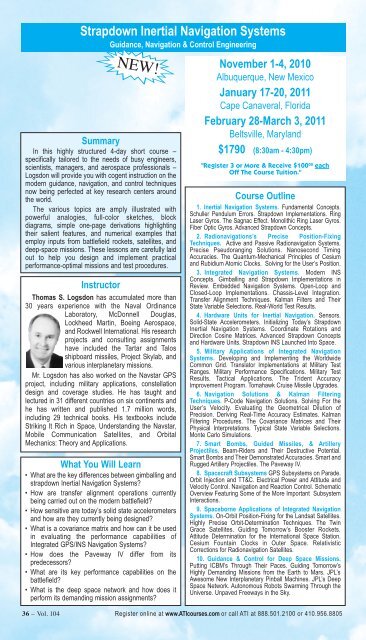Systems Engineering - ATI
Systems Engineering - ATI
Systems Engineering - ATI
Create successful ePaper yourself
Turn your PDF publications into a flip-book with our unique Google optimized e-Paper software.
Strapdown Inertial Navigation <strong>Systems</strong><br />
Guidance, Navigation & Control <strong>Engineering</strong><br />
Summary<br />
In this highly structured 4-day short course –<br />
specifically tailored to the needs of busy engineers,<br />
scientists, managers, and aerospace professionals –<br />
Logsdon will provide you with cogent instruction on the<br />
modern guidance, navigation, and control techniques<br />
now being perfected at key research centers around<br />
the world.<br />
The various topics are amply illustrated with<br />
powerful analogies, full-color sketches, block<br />
diagrams, simple one-page derivations highlighting<br />
their salient features, and numerical examples that<br />
employ inputs from battlefield rockets, satellites, and<br />
deep-space missions. These lessons are carefully laid<br />
out to help you design and implement practical<br />
performance-optimal missions and test procedures.<br />
Instructor<br />
NEW!<br />
Thomas S. Logsdon has accumulated more than<br />
30 years experience with the Naval Ordinance<br />
Laboratory, McDonnell Douglas,<br />
Lockheed Martin, Boeing Aerospace,<br />
and Rockwell International. His research<br />
projects and consulting assignments<br />
have included the Tartar and Talos<br />
shipboard missiles, Project Skylab, and<br />
various interplanetary missions.<br />
Mr. Logsdon has also worked on the Navstar GPS<br />
project, including military applications, constellation<br />
design and coverage studies. He has taught and<br />
lectured in 31 different countries on six continents and<br />
he has written and published 1.7 million words,<br />
including 29 technical books. His textbooks include<br />
Striking It Rich in Space, Understanding the Navstar,<br />
Mobile Communication Satellites, and Orbital<br />
Mechanics: Theory and Applications.<br />
What You Will Learn<br />
• What are the key differences between gimballing and<br />
strapdown Inertial Navigation <strong>Systems</strong><br />
• How are transfer alignment operations currently<br />
being carried out on the modern battlefield<br />
• How sensitive are today’s solid state accelerometers<br />
and how are they currently being designed<br />
• What is a covariance matrix and how can it be used<br />
in evaluating the performance capabilities of<br />
Integrated GPS/INS Navigation <strong>Systems</strong><br />
• How does the Paveway IV differ from its<br />
predecessors<br />
• What are its key performance capabilities on the<br />
battlefield<br />
• What is the deep space network and how does it<br />
perform its demanding mission assignments<br />
November 1-4, 2010<br />
Albuquerque, New Mexico<br />
January 17-20, 2011<br />
Cape Canaveral, Florida<br />
February 28-March 3, 2011<br />
Beltsville, Maryland<br />
$1790 (8:30am - 4:30pm)<br />
"Register 3 or More & Receive $100 00 each<br />
Off The Course Tuition."<br />
Course Outline<br />
1. Inertial Navigation <strong>Systems</strong>. Fundamental Concepts.<br />
Schuller Pendulum Errors. Strapdown Implementations. Ring<br />
Laser Gyros. The Sagnac Effect. Monolithic Ring Laser Gyros.<br />
Fiber Optic Gyros. Advanced Strapdown Concepts.<br />
2. Radionavigations’s Precise Position-Fixing<br />
Techniques. Active and Passive Radionavigation <strong>Systems</strong>.<br />
Precise Pseudoranging Solutions. Nanosecond Timing<br />
Accuracies. The Quantum-Mechanical Principles of Cesium<br />
and Rubidium Atomic Clocks. Solving for the User’s Position.<br />
3. Integrated Navigation <strong>Systems</strong>. Modern INS<br />
Concepts. Gimballing and Strapdown Implementations in<br />
Review. Embedded Navigation <strong>Systems</strong>. Open-Loop and<br />
Closed-Loop Implementations. Chassis-Level Integration.<br />
Transfer Alignment Techniques. Kalman Filters and Their<br />
State Variable Selections. Real-World Test Results.<br />
4. Hardware Units for Inertial Navigation. Sensors.<br />
Solid-State Accelerometers. Initializing Today’s Strapdown<br />
Inertial Navigation <strong>Systems</strong>. Coordinate Rotations and<br />
Direction Cosine Matrices. Advanced Strapdown Concepts<br />
and Hardware Units. Strapdown INS Launched Into Space.<br />
5. Military Applications of Integrated Navigation<br />
<strong>Systems</strong>. Developing and Implementing the Worldwide<br />
Common Grid. Translator Implementations at Military Test<br />
Ranges. Military Performance Specifications. Military Test<br />
Results. Tactical Applications. The Trident Accuracy<br />
Improvement Program. Tomahawk Cruise Missile Upgrades.<br />
6. Navigation Solutions & Kalman Filtering<br />
Techniques. P-Code Navigation Solutions. Solving For the<br />
User’s Velocity. Evaluating the Geometrical Dilution of<br />
Precision. Deriving Real-Time Accuracy Estimates. Kalman<br />
Filtering Procedures. The Covariance Matrices and Their<br />
Physical Interpretations. Typical State Variable Selections.<br />
Monte Carlo Simulations.<br />
7. Smart Bombs, Guided Missiles, & Artillery<br />
Projectiles. Beam-Riders and Their Destructive Potential.<br />
Smart Bombs and Their Demonstrated Accuracies. Smart and<br />
Rugged Artillery Projectiles. The Paveway IV.<br />
8. Spacecraft Subsystems GPS Subsystems on Parade.<br />
Orbit Injection and TT&C. Electrical Power and Attitude and<br />
Velocity Control. Navigation and Reaction Control. Schematic<br />
Overview Featuring Some of the More Important Subsystem<br />
Interactions.<br />
9. Spaceborne Applications of Integrated Navigation<br />
<strong>Systems</strong>. On-Orbit Position-Fixing for the Landsat Satellites.<br />
Highly Precise Orbit-Determination Techniques. The Twin<br />
Grace Satellites. Guiding Tomorrow’s Booster Rockets.<br />
Attitude Determination for the International Space Station.<br />
Cesium Fountain Clocks in Outer Space. Relativistic<br />
Corrections for Radionavigation Satellites.<br />
10. Guidance & Control for Deep Space Missions.<br />
Putting ICBM’s Through Their Paces. Guiding Tomorrow’s<br />
Highly Demanding Missions from the Earth to Mars. JPL’s<br />
Awesome New Interplanetary Pinball Machines. JPL’s Deep<br />
Space Network. Autonomous Robots Swarming Through the<br />
Universe. Unpaved Freeways in the Sky.<br />
36 – Vol. 104 Register online at www.<strong>ATI</strong>courses.com or call <strong>ATI</strong> at 888.501.2100 or 410.956.8805

















